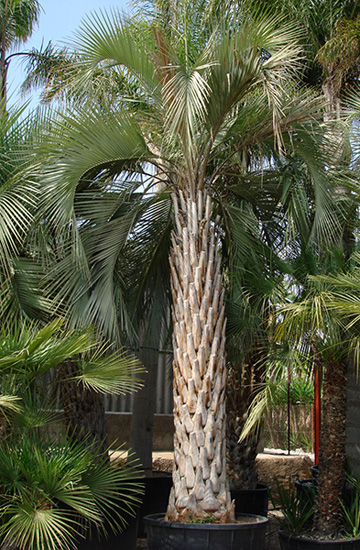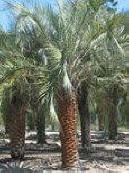Pindo Palm Trees - Butia capitata
Butia capitata, the Pindo Palm can grow up to 20 feet and has:
-
Long, feathered leaves
-
Leaves ranging from light green to bluish gray and
growing 5 to 10 feet long.
-
The trunk normally reaches 12 to
15 feet with a diameter of 1 to
15 feet.

Pindo Palm Tree (Butia capitata) Information
This beautiful feather palm
trees have long pinnate leaves that arch and recurve
towards the ground from atop a thick stout trunk. The trunk can grow to 20 feet,
but normally reaches 12 to 15 feet with a diameter of 1 to 1.5 feet. Typically,
the old leaf stalks persist for years, although specimens with clean trunks are
not uncommon. Leaves range from light green to bluish gray and grow 5 to 10 feet
long. The leaf stems range from about 2 to 4 feet in length and have spines
along both edges. The palm produces bright orange fruit (often called pindo
dates in the deep south). These palms vary in form. Specimens raised in dry
and/or infertile soils tend to be smaller in stature with smaller leaves. Light
also affects the plant's form while those grown in full sun are more compact.
This cold-hardy, single-trunked Pindo palm is easily recognized by its rounded canopy of blue-grey, strongly-recurved, graceful fronds which curve in toward the trunk. The heavy, stocky trunks are covered with persistent leaf bases. Large, showy clusters of orange-yellow, juicy, edible fruits, the size of large dates, are produced and often used to make jams or jellies. The fruit, ripening in summer, can be messy on sidewalks or patios, so you may want to plant 10 feet away from the walk or patio. This slow-growing palm eventually will reach 20 feet tall and is attractive as a freestanding specimen or grouped with other palms. Most are seen smaller than this since growth rate is very slow. Plant 10 feet apart as a street tree and they can be planted beneath power lines due to slow growth and small size.
Pindo Palm Tree Description
Scientific name: Butia capitata
Pronunciation: BEW-tee-uh kap-ih-TAY-tuh
Common name(s): Pindo Palm, Jelly Palm
Family: Arecaceae
USDA hardiness zones: 8B through 11 (Fig. 2)
Origin: not native to North America
Invasive potential: little invasive potential
Uses: street without sidewalk; deck or patio; specimen; parking lot island < 100 sq ft; parking lot island 100-200 sq ft; parking lot island > 200 sq ft; tree lawn 3-4 feet wide; tree lawn 4-6 feet wide; tree lawn > 6 ft wide; urban tolerant; highway median
Availability: not native to North America
Description
Height: 15 to 25 feet
Spread: 10 to 15 feet
Crown uniformity: symmetrical
Crown shape: palm, upright/erect
Crown density: open
Growth rate: slow
Texture: coarse
Pindo Palm Foliage
Leaf arrangement: spiral (Fig. 3)
Leaf type: odd-pinnately compound
Leaf margin: entire
Leaf shape: linear
Leaf venation: parallel
Leaf type and persistence: evergreen
Leaf blade length: 18 to 36 inches
Leaf color: silver, blue or blue-green
Fall color: no color change
Fall characteristic: not showy
Pindow Palm Tree Flower
Flower color: white/cream/gray
Flower characteristics: showy
Pindo Fruit
Fruit shape: round
Fruit length: .5 to 1 inch
Fruit covering: fleshy
Fruit color: yellow, orange
Fruit characteristics: attracts squirrels/mammals; showy; fruit/leaves a litter problem
Pindo Palms Trunk and Branches
Trunk/bark/branches: branches don't droop; not showy; typically one trunk; thorns
Pruning requirement: little required
Breakage: resistant
Current year twig color: not applicable
Current year twig thickness:
Wood specific gravity: unknown
Pindo Palm Trees Culture
Light requirement: full sun, partial sun or partial shade
Soil tolerances: clay; sand; loam; slightly alkaline; acidic; well-drained
Drought tolerance: high
Aerosol salt tolerance: high
OtherRoots: not a problem
Winter interest: no
Outstanding tree: no
Ozone sensitivity: unknown
Verticillium wilt susceptibility: resistant
Pest resistance: resistant to pests/diseases
Pindo Palm Trees Usage
This palm makes a great accent
which fits well into small areas like courtyards and
entries. It is a tough plant and survives in hot urban
landscapes and even thrives there if watered and fed.
PestsPindo Palm Pests
Palm leaf skeletonizer, scale, and micronutrient deficiencies (especially Mn and Fe) are occasional problems for pindo palm. Micronutrient deficiencies only show up on soil with a high pH.
Pindo Palm Tree Diseases
DiseasesNo diseases are of major concern. The roots and lower trunk can rot if soil is kept too moist.
|


Pindo Palm Tree
Small - $ 94.95
Retail Price: 113.94
You Save: $18.99

Pindo Palm Tree
Medium - $ 399.95
Retail Price: 479.94
You Save: $79.99
Other Cold Hardy Palms you might be interested in:
True Date Palms (Phoenix dactylifera)
(Sabal mexicana)
(Butia capitata)
(Cycas revoluta)



|








